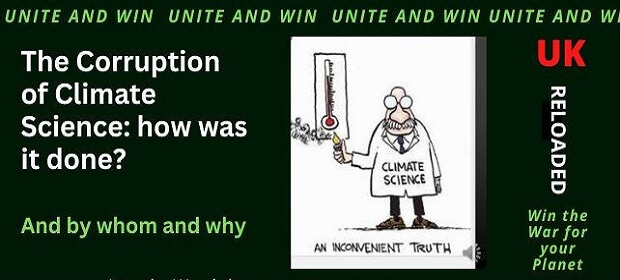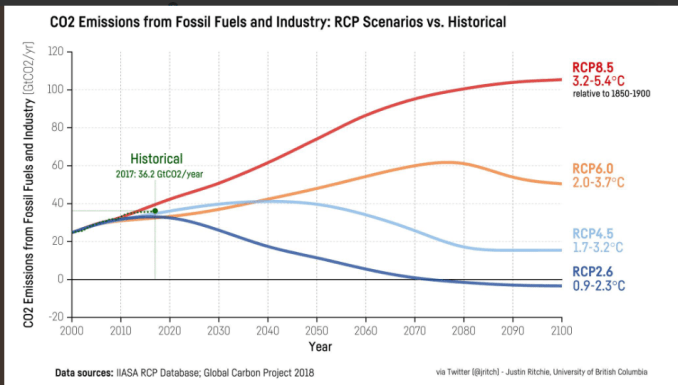Source: https://libertyrising.substack.com/p/the-corruption-of-climate-science
We present here an intelligent analysis featured on the Friends of Science website here, followed by a link to an illuminating article published on Forbes, here, entitled “How Billionaires Tom Steyer and Michael Bloomberg Corrupted Climate Science.”
BETWEEN THE IMPLAUSIBLE AND IMPOSSIBLE:
The Misused Scenario Driving Climate Emergency Policies
by Robert Lyman’s bio can be read here.
EXECUTIVE SUMMARY
Over the period since the 1870’s, global average temperatures have risen about 1.1 degree Celsius.
That is one degree over a century and a half, so slight that the average person would rarely notice the change. Consequently, to show that the world is facing catastrophe, climate activists have based their claims on the climate models used by the Intergovernmental Panel on Climate Change (IPCC) to project the future.
When projecting the future, climate modelers use different sets of assumptions about how the world population and energy economy will change over the period to 2100 and beyond.
During the preparation of its Fifth Assessment Report in 2014, the Intergovernmental Panel on Climate Change (IPCC) decided to use four “Representative Concentration Pathways” (RCPs), meaning scenarios developed by modelers regarding carbon dioxide-equivalent concentrations in the earth’s atmosphere.
The pathways were labelled RCP2.6, RCP 4.5. RCP6 and RCP8.5. They were initially developed with the understanding that the scenarios, and the models that used them, were simply scientific tools aimed at exploring a variety of conditions as a way to test hypotheses and researchers’ understanding of the climate system.
The IPCC, however, associated the RCP scenarios with likelihoods of happening when it labeled the scenario leading to the largest amount of climate change, RCP8.5, as the single “business-as-usual” scenario of the set. As Roger Pielke has observed, “In so doing, the IPCC identified RCP8.5 as the most likely future in the absence of further policy intervention, which gave it special status among not only the RCPs but among the hundreds of baseline scenarios of the broader IPCC scenario database.”
The RCP 8.5 scenario was very different from the others. It was perceived as depicting the situation that might prevail “without climate policy”; in other words, if the countries of the world took no measures to reduce GHG emissions beyond those in place in 2014. RCP8.5 has annual carbon dioxide emissions more than tripling by century’s end, the concentration of carbon dioxide in the atmosphere soaring to more than 900 parts per million, and the radiative forcing (i.e. a scientific concept used to quantify and compare the external drivers of change to Earth’s energy balance) more than triple what it is today.
Some of the most prestigious experts, such as Dr. Judith Curry, have characterized RCP8.5 as clearly “implausible” implying that it has less than a 2% chance of occurring. It was undoubtedly intended by the modelers to be a “worst case”.
A group of American billionaires and prominent climate activists including Tom Steyer and Michael Bloomberg launched a series of reports and a sophisticated publicity campaign (the “Risky Business” project) characterizing RCP8.5 as “business as usual” and the RCP scenarios as presenting different policy outcomes, suggesting that countries could move from one scenario to another.
The campaign has been phenomenally successful. The methodology promoted by the Risky Business project has been adopted by the US federal government and several US states and municipalities, as well as the National Academy of Sciences. Canadian government reports concerning the potential adverse effects of climate change probably also rely on this scenario, although they are usually less transparent about the assumptions on which they rely.
According to Google Scholar, from the beginning of 2020 until mid-June 2021 alone, authors published more than 8,500 papers using the implausible baseline scenarios. The worst mis-users of the worst-case scenarios, of course, are the journalists who seek only the sensationalist headline, regardless of how much it misleads the public.
Without the attention and credibility given to RCP8.5, it is doubtful that a persuasive case could be made for high carbon dioxide taxes or “net-zero by 2050” policies.
RCP8.5 is a perverse corruption of climate science and an extraordinarily damaging propaganda tool used by climate campaigners. It does not even remotely provide a credible basis for projecting the future; its probability ranges between the implausible and the impossible.
However, by the magic of misrepresentation and skillful public relations, the worst case became in the public’s mind the “most likely” case.



No comments:
Post a Comment
Note: only a member of this blog may post a comment.